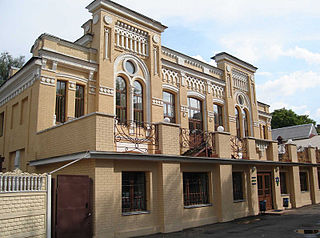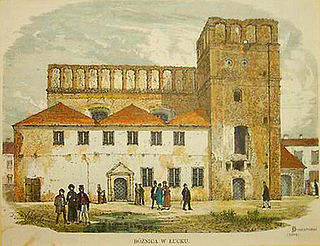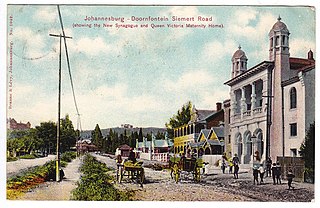
Volgograd, formerly Tsaritsyn (1589–1925) and Stalingrad (1925–1961), is the largest city and the administrative centre of Volgograd Oblast, Russia. The city lies on the western bank of the Volga, covering an area of 859.4 square kilometres, with a population of slightly over one million residents. Volgograd is the 16th-largest city by population size in Russia, the second-largest city of the Southern Federal District, and the fourth-largest city on the Volga.

Beit Shemesh is a city located approximately 30 kilometres (19 mi) west of Jerusalem in Israel's Jerusalem District. A center of Haredi Judaism and Modern Orthodoxy, Beit Shemesh has a population of 170,683 as of 2024.

The history of the Jews in Indonesia began with the arrival of early European explorers and settlers, and the first Jews arrived in the 17th century. Most Indonesian Jews arrived from Southern Europe, the United Kingdom, the Netherlands, Belgium, Germany, France, the Middle East, North Africa, India, China, and Latin America. Jews in Indonesia presently form a very small Jewish community of about 500–1,000, from a nadir of about 20 in 1997. Judaism is not recognized as one of the country's six major religions, however its practices are allowed under Perpres 1965 No. 1 and article 29 paragraph 2 of the Constitution of Indonesia. Therefore, members of the local Jewish community have to choose to register as "Belief in One Almighty God" or another recognized religions on their official identity cards.

The history of the Jews in Luxembourg dates back to the 1200s. There are roughly 1,200 Jews in Luxembourg, and Jews form one of the largest and most important religious and ethnic minority communities in Luxembourg historically.

Beit Ha'Chidush, abbreviated as BHC is a Progressive Jewish congregation, located in Amsterdam, in the North Holland region of The Netherlands. The congregation was founded in 1995 by predominately expatriate Jews with secular and religious backgrounds who wanted to create a welcoming, inspiring and renewed Jewish congregation.

The Magen Abraham Synagogue is an Orthodox Jewish congregation and synagogue, located in the Old Town neighbourhood of Ahmedabad, in the state of Gujarat, India. As of 2015, it was the only synagogue in the entire state. It was built in 1934 using donations from members of the Bene Israel Jewish community of the state.

The Radomyshl Synagogue is a former Jewish synagogue that was located in the town of Radomyshl, Zhytomyr Oblast in Ukraine. It was built in 1887. A great fire in the town in 1926 damaged the building. It was demolished in the 1930s.
The Birobidzhan Synagogue, officially the Freyd Community and Beit Menachem Synagogue in Birobidzhan, is a Chabad Jewish congregation and synagogue, located at 19 Lenina Street, in the city of Birobidzhan, in the capital of the Jewish Autonomous Oblast, in Russia.

The Beit Warszawa Synagogue is a Reform Jewish congregation and synagogue, located at 113 Wiertnicza Street, in the district of Wilanów, Warsaw, in the Masovian Voivodeship of Poland. Designed in the Modernist style and completed in 2003, the synagogue has regular events, including Friday night and Saturday morning prayers. Beit Warszawa is a member of Beit Polska, the umbrella organization for the Progressive and Reform Jewish community in Poland.

The Beit T'shuva Synagogue is a Jewish congregation and synagogue, located at 7 Mayakovskogo Street, in the city of Birobidzhan, in the Jewish Autonomous Oblast of Russia.

The Halytska Synagogue, also called the Galitska Synagogue or Beit Yaakov Shul, is an Orthodox Jewish synagogue, located at 97a Zhylianska Street, in Kyiv, in the Kyiv Oblast of Ukraine. The congregation worships in the Ashkenazi rite.

The Włodawa Synagogue is a former Orthodox Jewish congregation and synagogue complex, located at 5-7 Czerwonego Krzyża Street, in Włodawa, in the Lublin Voivodeship of Poland. The synagogue complex comprises the Włodawa Great Synagogue, the Small Synagogue or Beit midrash, and a Jewish administrative building, all now preserved as a Jewish museum.

The Bet Israel Synagogue, also known as the Beit Israel Synagogue, is a Jewish congregation and synagogue located at 265 Mithatpaşa Street, in the Turgut Reis neighbourhood, in the Karataş quarter of the city of İzmir, in the İzmir Province of Turkey. The synagogue was completed in 1907 and is the largest synagogue in the city, the other major synagogue being the Shaar Hashamaym Synagogue.

The Israelite Center of Paraná is a Jewish cultural center and Conservative synagogue, located in the city of Curitiba, in the state of Paraná, in southern Brazil. The synagogue is called the Beit Yaacov Synagogue. The centre was completed in 2011 and in addition to communal space, it houses a synagogue, Jewish day school, and a Holocaust museum.

The Great Synagogue is a former Orthodox Jewish synagogue, located at 33 Karaimska Street, in the Jewish quarter of Lutsk, in Volynska Oblast, Ukraine. The congregation worshipped in the Ashkenazi rite.

The Historic Synagogue Justo Sierra 71, formerly known as Nidjei Israel Synagogue, is an Orthodox Jewish congregation, synagogue, and cultural center, located at Justo Sierra 71, in the historic center of Mexico City, in Mexico. The building was completed in 1941 and serves both as a synagogue and cultural center of the Ashkenazi Jewish community.

The Piaskower Synagogue is a former Orthodox Jewish congregation and synagogue, located at 3 Piękna Street, in the Piaski district of Białystok, in the Podlaskie Voivodeship of Poland.

The Doornfontein Synagogue or Lions Synagogue is an Orthodox Jewish congregation and synagogue, located at 120 Siemert Road, New Doornfontein, in Greater Johannesburg, in the region of Gauteng, South Africa. It is the oldest synagogue in use in South Africa. The synagogue is located two blocks from Ellis Park Stadium.
Beit Emanuel, formally the Temple Emamuel, is a Progressive Jewish congregation and synagogue, located in Parktown, a suburb of Johannesburg, in the district of Gauteng, South Africa. The synagogue was established in 1954 and is one of the largest Progressive Jewish congregations in South Africa. It is an affiliate of the South African Union for Progressive Judaism (SAUPJ), which is part of the World Union for Progressive Judaism (WUPJ).

The Derbent Synagogue, also known as Kele-Numaz was a former Orthodox Jewish congregation and synagogue, located at 94 Tagi-Zade Street, in the city of Derbent in the Republic of Dagestan, in the North Caucasus of Russia.



















